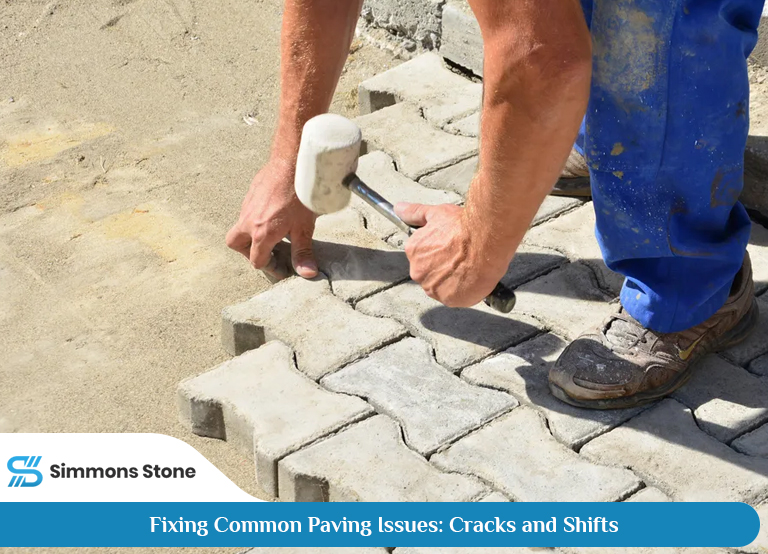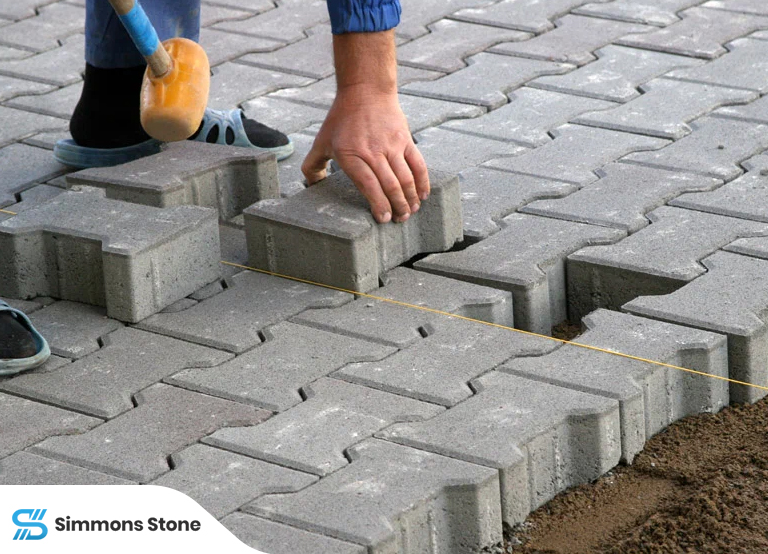Fixing Common Paving Issues: Cracks and Shifts
Imagine your driveway or patio as a big puzzle. Sometimes, the pieces of this puzzle can start to break or move around. This is what happens when we see cracks or shifts in our paving. It’s a common problem that many people face with their outdoor spaces. These issues can make our driveways and patios look messy. They can also be dangerous to walk on. But don’t worry!
There are ways to fix these problems. In this guide, we’ll talk about why cracks and shifts happen. We’ll also learn how to spot them early. Most importantly, we’ll discover simple ways to fix them. Whether you have a concrete driveway or a brick patio, this information will help. By the end, you’ll know how to keep your outdoor spaces looking nice and safe to use. Let’s dive in and learn how to be paving problem solvers!

Understanding Paving Issues
What Causes Cracks?
Cracks in paving can happen for many reasons. Here are some common ones:
- The ground underneath moves or settles.
- The weather gets very hot or very cold.
- Water gets into tiny spaces and then freezes.
- Heavy things like cars put too much weight on the paving.
- Tree roots grow under the paving and push it up.
Knowing why cracks happen can help us prevent them.
Types of Cracks
Not all cracks are the same. Here are some types you might see:
- Hairline cracks: These are very thin and small.
- Spider web cracks: These look like a spider’s web.
- Deep cracks: These go all the way through the paving.
- Long cracks: These can stretch across the whole driveway or patio.
Each type of crack might need a different way to fix it.
What Causes Shifts?
Shifts happen when parts of the paving move. This can happen because:
- The soil underneath isn’t stable.
- Water washes away the soil under the paving.
- The edges of the paving aren’t supported well.
- The paving wasn’t put down properly in the first place.
- Earthquakes or other natural events shake the ground.
Shifts can make your paving uneven and wobbly.
Identifying Paving Problems
Signs of Cracks
It’s important to spot cracks early. Here’s what to look for:
- Thin lines on the surface of your paving.
- Places where water collects after rain.
- Parts of the paving that feel rough when you walk on them.
- Areas where small pieces of paving are coming loose.
Check your paving regularly to catch problems early.
Signs of Shifts
Shifts can be tricky to spot. Watch out for these signs:
- Parts of the paving that are higher or lower than others.
- Edges of paving stones that don’t line up.
- Spaces between paving stones that are wider in some places.
- Areas where water runs off in a different direction than before.
If you notice these signs, your paving might be shifting.
Simple Fixes for Cracks
Cleaning the Crack
Before fixing a crack, you need to clean it. Here’s how:
- Sweep away any dirt or leaves.
- Use a garden hose to wash out the crack.
- Let it dry completely.
- Use a wire brush to remove any loose bits.
Clean cracks are easier to fix properly.
Filling Small Cracks
For tiny cracks, you can use a special filler. Follow these steps:
- Buy a crack filler made for your type of paving.
- Squeeze the filler into the crack.
- Use a putty knife to smooth it out.
- Let it dry according to the instructions.
This works well for hairline and small cracks.
Patching Larger Cracks
Bigger cracks need a stronger fix. Here’s what to do:
- Widen the crack a little with a chisel.
- Clean out all the loose material.
- Fill the crack with patching compound.
- Smooth it out and let it dry.
- Add more layers if needed.
This method works for deeper or wider cracks.
Sealing the Surface
After fixing cracks, it’s good to seal the whole surface. This helps:
- Protect against new cracks.
- Keep water out.
- Make the paving look better.
Use a sealer made for your type of paving and follow the instructions carefully.
Fixing Shifts in Paving
Lifting and Relaying
For shifted paving stones, you might need to lift and relay them. Here’s how:
- Carefully remove the shifted stones.
- Level out the ground underneath.
- Add sand or gravel to create a flat base.
- Put the stones back in place.
- Use a level to make sure they’re even.
This works well for brick or stone paving.
Mudjacking
For concrete slabs that have sunk, mudjacking can help. It involves:
- Drilling small holes in the concrete.
- Pumping a special mix under the slab.
- The mix lifts the slab back into place.
- Filling the holes when done.
This is a big job and might need special tools.
Edge Support
Sometimes, the edges of paving can sink. To fix this:
- Dig out the area around the edge.
- Add a layer of gravel for drainage.
- Use edging material to support the paving.
- Fill in with soil and compact it.
Strong edges help keep your paving in place.
Preventing Future Problems
Regular Maintenance
Taking care of your paving can prevent issues. Try these tips:
- Clean your paving regularly.
- Fill small cracks as soon as you see them.
- Check for loose stones or uneven areas.
- Keep water draining away from your paving.
A little care goes a long way in keeping your paving nice.
Proper Drainage
Good drainage is super important. Here’s what you can do:
- Make sure water flows away from your paving.
- Keep gutters and drains clear.
- Fix any low spots where water collects.
- Consider adding drain pipes if needed.
Dry paving lasts longer and looks better.
Dealing with Tree Roots
Tree roots can cause big problems. To prevent this:
- Plant trees away from paved areas.
- Use root barriers for existing trees.
- Remove problem roots carefully.
- Choose trees with less invasive roots.
Trees are great, but not when they damage your paving!
Weather Protection
The weather can be tough on paving. Protect it by:
- Sealing the surface every few years.
- Using de-icing products carefully in winter.
- Covering areas that get a lot of sun in summer.
- Fixing any damage quickly after storms.
A little protection can stop big problems later.
When to Seek Professional Help
Sometimes, paving problems are too big to fix on your own. You might need help if:
- The cracks are very deep or wide.
- Large areas of paving are sinking.
- You see lots of cracks all over.
- Water is causing serious damage.
- The ground underneath feels soft or unstable.
It’s okay to ask for help with big paving problems.
Fixing cracks and shifts in your paving doesn’t have to be scary. With a little know-how, you can tackle many common issues. Remember to keep an eye out for problems and fix them early. Clean and fill small cracks before they get bigger. Level out shifted areas to keep your paving even. And don’t forget to take good care of your paving to stop new problems.
Regular cleaning and maintenance can make a big difference. By following these tips, you can keep your driveway, patio, or walkway looking great for years to come. Your outdoor spaces will be safer and more enjoyable for everyone. So go ahead, be a paving superhero and show those cracks and shifts who’s boss!
FAQ
How often should I inspect my paving for cracks and shifts?
It’s a good idea to check your paving at least twice a year, typically in spring and fall. Also, inspect after severe weather events like heavy rains or freezing temperatures. Regular checks help catch problems early when they’re easier to fix.
Can I use plants or moss to fill cracks in my paving creatively?
Yes, you can use plants like creeping thyme or moss for small cracks in areas with light foot traffic. This eco-friendly approach adds greenery and character. However, ensure proper drainage and choose plants that won’t cause further damage as they grow.
Are there any eco-friendly materials I can use for fixing paving issues?
There are several eco-friendly options available. Look for sealants and fillers made from recycled materials or natural ingredients. Some companies offer products made from plant-based polymers or recycled rubber. These can be effective and better for the environment.
How can I tell if the issue with my paving is superficial or indicates a more serious underlying problem?
Superficial issues usually involve small, shallow cracks or minor unevenness. More serious problems often show multiple, deep cracks, significant shifts, or areas that feel soft underfoot. If you’re unsure, it’s best to consult with a professional for a thorough assessment.
